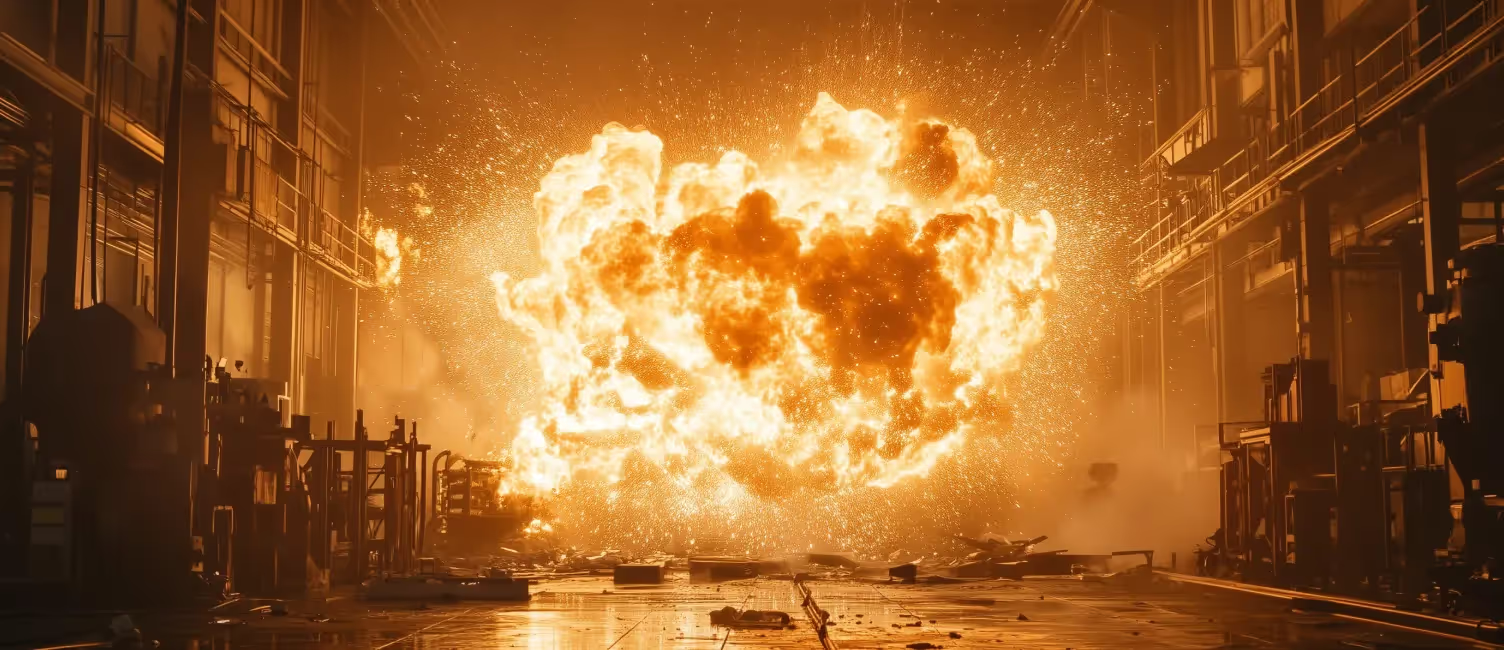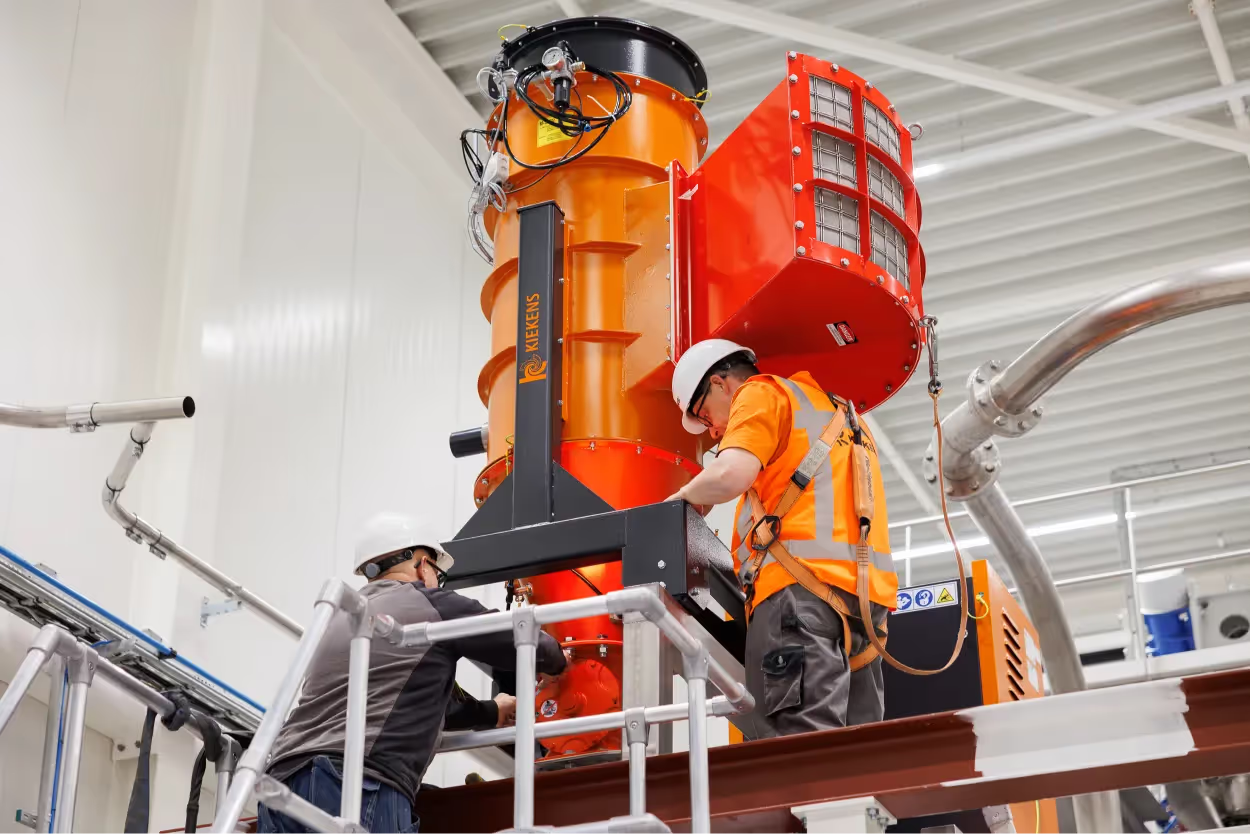KST value explained: how to prevent dust explosions in your installation

What is the KST value?
The KST value is a measure of the rate of pressure rise during a dust explosion in a dust-air mixture. In other words, it indicates how quickly pressure increases when an explosion occurs.
The strength of an explosion, on the other hand, is determined by the Pmax value: the maximum pressure reached during the explosion. A high KST value means that the explosion pressure builds up rapidly, which places greater demands on explosion protection and pressure relief systems. For companies, the KST value is therefore a crucial parameter when designing safe extraction systems and selecting appropriate technical safety measures.
The role of KST value in safe industrial extraction
The KST value is a fundamental basis for explosion protection measures in the industry. It is used, among other things, for:
- The design of protection systems such as burst discs, pressure relief systems and fire fighting systems.
- The division of risk areas into explosive zones (Zone 20, 21 or 22).
- The choice of filters and extraction systems: are ATEX components or overpressure protectors required?
- The construction of dust explosion-proof installations in woodworking, metalworking or food processing.
Harriers integrates these key figures as standard in every quote and design phase. Our extraction systems are designed to operate as safely as possible even under realistic conditions with varying dust concentrations and particle sizes — with the right security technology.
In this way, an apparently theoretical laboratory value is translated into a practical safety basis. Your production environment remains reliably protected, even under demanding conditions.
Dust-air mixtures and their risks
Dust-air mixtures are created wherever fine particles end up in the air and mix with oxygen. Such aerosols provide almost ideal conditions for a dust explosion: the finer the particles, the larger the surface area and the more intense the reaction.
Substances such as wood dust, flower dust or metal dust are extra risky because of their high flammability and KST value. When these mixtures come into contact with ignition sources such as sparks, hot surfaces, or electrostatic discharges, an explosion can occur. It then spreads rapidly through the room and causes pressure peaks.
In addition to the maximum explosion pressure, the pressure increase And thus the KST value is an important safety parameter. Without the right security measures, there is a significant risk for installations, buildings and, in particular, for employees in the workplace.
Dust explosion classes and classification based on KST value
Combustible substances are classified into four based on their KST value dust explosion classes:
- ST 0 KST = 0 bar · m/s - No explosion hazard Quartz dust
- St 1 KST > 0 — 200 bar m/s - Light explosiveness Wood dust, sugar dust
- ST 2 KST > 200 — 300 bar m/s - Medium explosiveness Cellulose, wood flour
- ST 3 KST > 300 bar m/s - High explosiveness Metal dust, such as aluminum dust
This classification is crucial for the design of security systems. For example, simple pressure relief is often sufficient for St 1, while St 3 requires extensive explosion protection.
This provides companies with a clear framework for correctly analyzing dust properties, determining the correct dust class and deriving appropriate explosion protection measures.
How is the KST value determined?
The KST value was determined via a standardized test protocol in a 1 m³ spherical test chamber. A carefully weighed dust-air mixture is blown into it and then ignited with a spark.
The maximum pressure increase (dp/dt max) is then measured with pressure gauges. This value is normalized according to the so-called cubic law:
<sup>KST = (dp/dt) <sub>max × V 1/3</sub></sup>
where with all V the volume of the test chamber is (1 m³). The test is carried out several times with different concentrations in order to achieve a reliable maximum value.
The conditions during the test process are standardized so that the results are reliable and reproducible.
Application of the KST value in extraction technology
The KST value forms the basis for the safe design of industrial extraction systems. Among other things, he determines:
- Construction and pressure protection: Installation of burst discs, check valves and explosion windows, tailored to expected explosion pressure.
- Material and component selection: ATEX-compliant filters and housings, tailored to the KST value and pressure dynamics.
- Air volume & air conduction: These are designed so that the dust concentration remains below the explosion limit.
- Hazardous zones: The KST value in combination with the dust concentration determines the division into zones 20, 21 or 22 and the required protection class of equipment.
Bee Harriers all these values are included in the engineering — from the initial design to the final installation. Always provided with appropriate security, accurate documentation and appropriate certifications. This keeps your work environment clean and safe.
Kiekens: Safety through technology
As a manufacturer with more than 100 years of experience in industrial extraction technology, explosion protection high on the agenda at Kiekens. We provide customized solutions, including determining the KST value of your fabric mixture and the resulting ATEX format.
Our installations are robust, quiet, easy to maintain and equipped with smart details such as quick-change filters and viewing windows. Throughout the entire process, we offer support: from risk analysis, baseline measurement and installation to training, maintenance and full documentation in accordance with legislation.
The Kst value is a substance-specific measure (in bar·m/s) of the maximum pressure increase during a dust explosion. This value determines the dust explosion class (from St 0 to St 3) and forms the basis for explosion protection measures.
The KST value of wood ddddust is usually under 200 bar·m/s. That's what it comes in dust explosion class St 1.
Dust explosion class St 1 indicates that a substance has a moderate explosiveness, with a KST value of up to 200 bar·m/s. This means that protection measures in accordance with ATEX guidelines are required, but these are less complex than, for example, St 3.




